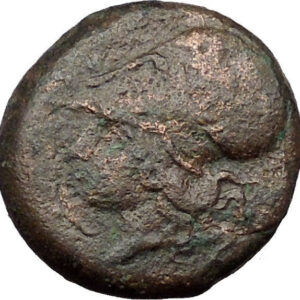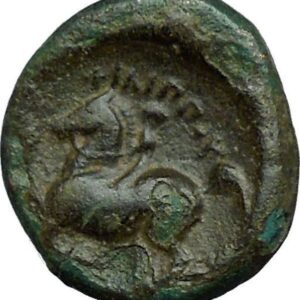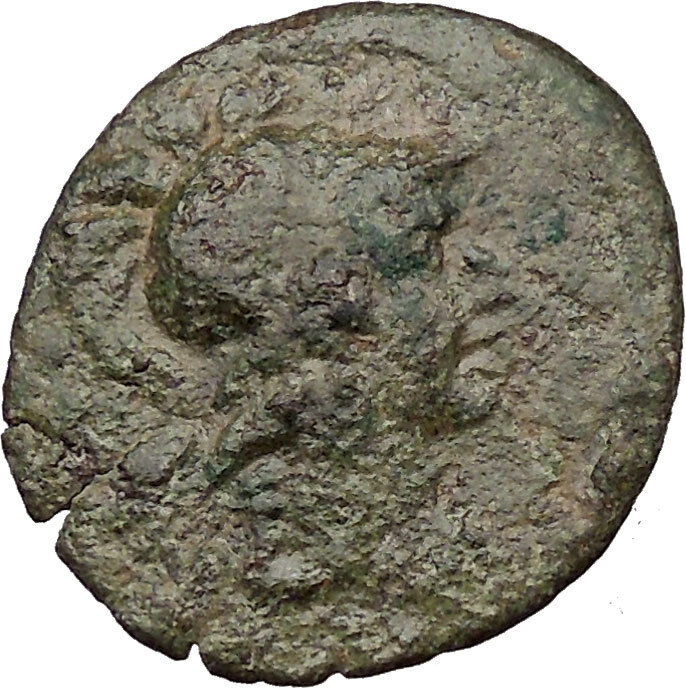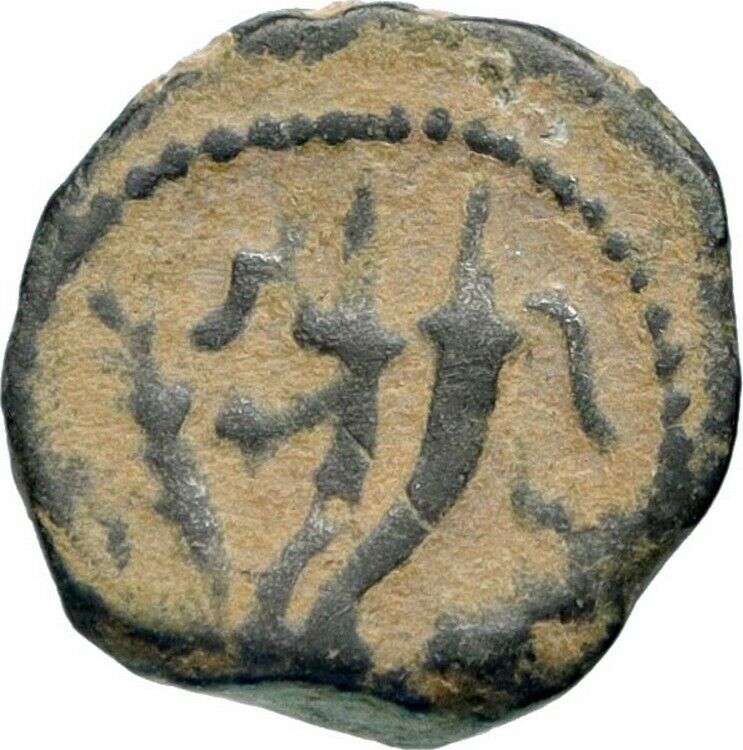|
Greek city of Arados in Phoenicia circa 245-165 B.C.
Posthumous issue in the name and types of Alexander III the Great – King of Macedonia: 336-323 B.C.
Silver Tetradrachm 29mm (17.10 grams)
Dated Civic Year 60, struck 200/199 B.C.
Reference: Price 3390
Certification: NGC Ancients Ch VF Strike: 5/5 Surface: 3/5 3998013-021
Head of Alexander the Great as Hercules right, wearing the lion-skin headdress.
AΛEΞANΔΡOY, Zeus seated left on backless throne, right leg drawn back, feet on ground line, eagle in right hand, scepter in left; palm tree in left field, AP monogram below throne, Ξ (date) in exergue.
* Numismatic Note: Alexander the Great coin types were used as standard for trade in the ancient Greek world, and were issued for hundreds of years after his death in various Greek cities.
An island off the coast of Phoenicia, at the distance of 20 stadia (2 geog. miles), with a city which occupied the whole surface of the island, 7 stadia in circumference, which was said to have been founded by exiles from Sidon, and which was a very flourishing place under its own kings, under the Seleukids, and under the Romans. An important city of northern Phoenicia, Arados itself occupied an island but it controlled an extensive area on the mainland. It possessed a harbor on the mainland, called Antaradus.
Best known as Alexander the Great, he was a king (basileus in Greek) of the Ancient Greek kingdom of Macedonia. He was born in the city of Pella in 356 BC. By age 20, Alexander succeeded his father Philip II to the throne as king. He spent most of his years as king in an unprecedented military campaign of conquest through Asia, northeast Africa and even reached India. By age 30 he created one of the biggest empires in the ancient world, reaching from Greece to northwestern India. Being undefeated in battle, many consider him as one of history’s most successful military commanders. He could be considered one of history’s most important figures, having spread the Greek civilization far and wide, and was even admired by Julius Caesar along with many other important historical personages as well.
You are bidding on the exact item pictured, provided with a Certificate of Authenticity and Lifetime Guarantee of Authenticity.

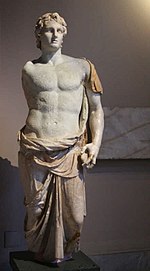 Alexander III of Macedon (20/21 July 356 BC – 10/11 June 323 BC), commonly known as Alexander the Great, was a king (basileus) of the Ancient Greek kingdom of Macedon and a member of the Argead dynasty. Born in Pella in 356 BC, Alexander succeeded his father, Philip II, to the throne at the age of twenty. He spent most of his ruling years on an unprecedented military campaign through Asia and northeast Africa, and by the age of thirty he had created one of the largest empires of the ancient world, stretching from Greece to northwestern India. He was undefeated in battle and is widely considered one of history’s most successful military commanders. Alexander III of Macedon (20/21 July 356 BC – 10/11 June 323 BC), commonly known as Alexander the Great, was a king (basileus) of the Ancient Greek kingdom of Macedon and a member of the Argead dynasty. Born in Pella in 356 BC, Alexander succeeded his father, Philip II, to the throne at the age of twenty. He spent most of his ruling years on an unprecedented military campaign through Asia and northeast Africa, and by the age of thirty he had created one of the largest empires of the ancient world, stretching from Greece to northwestern India. He was undefeated in battle and is widely considered one of history’s most successful military commanders.
During his youth, Alexander was tutored by the philosopher Aristotle until the age of 16. After Philip’s assassination in 336 BC, Alexander succeeded his father to the throne and inherited a strong kingdom and an experienced army. Alexander was awarded the generalship of Greece and used this authority to launch his father’s Panhellenic project to lead the Greeks in the conquest of Persia. In 334 BC, he invaded the Achaemenid Empire, and began a series of campaigns that lasted ten years. Following the conquest of Asia Minor, Alexander broke the power of Persia in a series of decisive battles, most notably the battles of Issus and Gaugamela. He subsequently overthrew the Persian King Darius III and conquered the Achaemenid Empire in its entirety. At that point, his empire stretched from the Adriatic Sea to the Indus River.
Seeking to reach the “ends of the world and the Great Outer Sea”, he invaded India in 326 BC, but eventually turned back at the demand of his homesick troops. Alexander died in Babylon in 323 BC, the city he planned to establish as his capital, without executing a series of planned campaigns that would have begun with an invasion of Arabia. In the years following his death, a series of civil wars tore his empire apart, resulting in several states ruled by the Diadochi, Alexander’s surviving generals and heirs.
 Alexander’s legacy includes the cultural diffusion his conquests engendered, such as Greco-Buddhism. He founded some twenty cities that bore his name, most notably Alexandria in Egypt. Alexander’s settlement of Greek colonists and the resulting spread of Greek culture in the east resulted in a new Hellenistic civilization, aspects of which were still evident in the traditions of the Byzantine Empire in the mid-15th century and the presence of Greek speakers in central and far eastern Anatolia until the 1920s. Alexander became legendary as a classical hero in the mold of Achilles, and he features prominently in the history and mythic traditions of both Greek and non-Greek cultures. He became the measure against which military leaders compared themselves, and military academies throughout the world still teach his tactics. He is often ranked among the most influential people in human history, along with his teacher Aristotle. Alexander’s legacy includes the cultural diffusion his conquests engendered, such as Greco-Buddhism. He founded some twenty cities that bore his name, most notably Alexandria in Egypt. Alexander’s settlement of Greek colonists and the resulting spread of Greek culture in the east resulted in a new Hellenistic civilization, aspects of which were still evident in the traditions of the Byzantine Empire in the mid-15th century and the presence of Greek speakers in central and far eastern Anatolia until the 1920s. Alexander became legendary as a classical hero in the mold of Achilles, and he features prominently in the history and mythic traditions of both Greek and non-Greek cultures. He became the measure against which military leaders compared themselves, and military academies throughout the world still teach his tactics. He is often ranked among the most influential people in human history, along with his teacher Aristotle.

Arwad (Arabic: أرواد) – formerly known as Arados (Greek: Ἄραδος), Arvad, Arpad, Arphad, and Antiochia in Pieria (Greek: Ἀντιόχεια τῆς Πιερίας), also called Ruad Island – located in the Mediterranean Sea, is the only inhabited island in Syria. The town of Arwad covers the entire island. It is located 3 kilometres (1.9 mi) from Tartus (ancient Tortosa), Syria’s second largest port. Today, it is mainly a fishing town. Plans have been unveiled in May 2016 to renovate the island to become a tourist attraction.
History Ancient history
The name Arvad is noted in the Bible as the progenitor of the Arvadites, a Canaanite people.
The island was settled in the early 2nd millennium BC by the Phoenicians. Under Phoenician control, it became an independent kingdom called Arvad Aradus or Jazirat (the latter term meaning “island”). The Phoenician name for the city was probably (Aynook). The city has been cited as one of the first known examples of a republic in the world, in which the people, rather than a monarch, are described as sovereign. In Greek it was known as Arados. The city also appears in ancient sources as Arpad and Arphad. The city was renamed Antiochia in Pieria by Antiochus I Soter. The island was important as a base for commercial ventures into the Orontes valley.
Located some 50 kilometres (31 mi) north of Tripolis, it was a barren rock covered with fortifications and houses several stories in height. The island was about 800 m long by 500 m wide, surrounded by a massive wall, and an artificial harbor was constructed on the east toward the mainland. It developed into a trading city in early times, as did most of the Phoenician cities on this coast. It had a powerful navy, and its ships are mentioned in the monuments of Egypt and Assyria. It seems to have had a sort of hegemony over the northern Phoenician cities, from the mouth of the Orontes to the northern limits of Lebanon, something like that of Sidon in the south. It had its own local dynasty and coinage, and some of the names of its kings have been recovered.
Its inhabitants are mentioned in the early lists of Genesis (10:18), and Ezekiel (27:8,11) refers to its seamen and soldiers in the service of Tyre. It brought under its authority some of the neighboring cities on the mainland, such as Marathos and Simyra, the former nearly opposite the island and the latter some kilometers to the south.
Thutmose III of Egypt took it in his campaign in north Syria (1472 BC), and it is noticed in the campaigns of Ramesses II in the early part of the 13th century BC (Breasted, Ancient Records). It is also mentioned in the Amarna Letters as being in league with the Amorites in their attacks on the Egyptian possessions in Syria (44 and 28, B.M. Tell el-Amarna Letters). About the year 1200 or later, it was sacked by invaders from Asia Minor or the islands, as were most of the cities on the coast (Paton, Syria and Palestine, 145), but it recovered when they were driven back.
Its maritime importance is indicated by the inscriptions of the Assyrian kings. Tiglath-pileser I (circa 1020) boasts that he sailed in the ships of Arvad. Ashurnasirpal II (circa 876) made it tributary, but it revolted, and 200 men of Arvad were mentioned among the allies of Hadadezer of Aram Damascus at the Battle of Qarqar, when all Syria seems to have been in league against Shalmaneser III (circa 854). At this time the king of Arvad was Mattan Baal. It was afterward tributary to Tiglath-pileser III and Sennacherib, the king who paid it to the latter being Abd-ilihit (circa 701). Ashurbanipal (circa 664) compelled its king Yakinlu to submit and send one of his daughters to become a member of the royal harem (Rawlinson, Phoenicia, 456-57).
Under the Persians, Arvad was allowed to unite in a confederation with Sidon and Tyre, with a common council at Tripolis (ibid, 484). When Alexander the Great invaded Syria in 332 BC, Arvad submitted without a struggle under her king Strato, who sent his navy to aid Alexander in the reduction of Tyre. It seems to have received the favor of the Seleucid kings of Syria, and enjoyed the right of asylum for political refugees. It is mentioned in a rescript from Rome about 138 BC, in connection with other cities and rulers of the East, to show favor to the Jews. This was after Rome had begun to interfere in the affairs of Judea and Syria, and indicates that Arvad was still of considerable importance at that time.
Bishopric
The city of Aradus, as it was then called, became a Christian bishopric. Athanasius reports that, under Roman Emperor Constantine the Great, Cymatius, the Catholic bishop of Aradus and also of Antaradus (whose names indicate that they were neighbouring towns facing each other) was driven out by the Arians. At the First Council of Constantinople in 381, Mocimus appears as bishop of Aradus. At the time of the Council of Ephesus (431), some sources speak of a Musaeus as bishop of Aradus and Antaradus, while others mention only Aradus or only Antaradus. Alexander was at the Council of Chalcedon in 451 as bishop of Antaradus, Paulus as bishop of Aradus, while, at a synod held at Antioch shortly before, Paulus took part as bishop of both Aradus and Antaradus.
In 458, Atticus signed, as bishop of Aradus, the letter of the bishops of the province of Phoenicia Prima to Byzantine Emperor Leo I the Thracian protesting about the murder of Proterius of Alexandria. Theodorus or Theodosius, who died in 518, is mentioned as bishop of Antaradus in a letter from the bishops of the province regarding Severus of Antioch that was read at a synod held by Patriarch Mennas of Constantinople. The acts of the Second Council of Constantinople in 553 were signed by Asyncretius as bishop of Aradus. At the time of the Crusades, Antaradus, by then called Tartus or Tortosa, was a Latin Church diocese, whose bishop also held the titles of Aradus and Maraclea (perhaps Rachlea).
It was united to the see of Famagusta in Cyprus in 1295. No longer a residential bishopric, Aradus is today listed by the Catholic Church as a titular see.
Crusades history
See also: Franco-Mongol alliance and Fall of Ruad
During the later part of the 13th century, in the time of the Crusades, the island of Ruad was used as a bridgehead or staging area by the Crusaders. It was the last piece of land that the Crusaders maintained in the Holy Land, as they were fighting a losing battle against the Muslims.
The Crusaders had lost control of the mainland in 1291 (see Fall of Acre), and the dwindling Kingdom of Jerusalem had been relocated to the island of Cyprus. In late 1300, in an attempt to coordinate military operations with the Mongol leader Ghazan, the Cypriots prepared a land-based force of approximately 600 men: 300 under Amalric of Lusignan, son of Hugh III of Cyprus, and similar contingents from the Templars and Hospitallers. The men and their horses were ferried from Cyprus to a staging area on Ruad, from which they launched raids on Tortosa while awaiting Mongol reinforcements. When the Mongols failed to arrive, the majority of the Christian forces returned to Cyprus, though a garrison was left on Ruad which was manned by rotating groups of different Cypriot forces. Pope Clement V formally awarded ownership of the island to the Knights Templar, who (in 1302) maintained a garrison with 120 knights, 500 bowmen and 400 Syrian helpers, under the Templar Maréchal (Commander-in-Chief) Barthélemy de Quincy.
In February 1301, the Mongols did arrive with a force of 60,000, but could do little else than engage in some raids around Syria. The Mongol leader Kutluka stationed 20,000 horsemen in the Jordan valley to protect Damascus, where a Mongol governor was installed. Soon however, they had to withdraw.
The Egyptian Mamluks, who had been systematically re-establishing control over Palestine and Syria, sought to take Ruad as well. A Mamluk fleet landed a force on the island, engaging in combat with the entrenched Templars, and then establishing a lengthy siege, culminating with the Fall of Ruad, and the Crusaders surrendering on September 26, 1302, following a promise of safe conduct. However, the promise was not honored: all the bowmen and Syrian helpers were killed, and the Templar knights were sent to Cairo prisons.
|










 Alexander III of Macedon (20/21 July 356 BC – 10/11 June 323 BC), commonly known as Alexander the Great, was a king (basileus) of the Ancient Greek kingdom of Macedon and a member of the Argead dynasty. Born in Pella in 356 BC, Alexander succeeded his father, Philip II, to the throne at the age of twenty. He spent most of his ruling years on an unprecedented military campaign through Asia and northeast Africa, and by the age of thirty he had created one of the largest empires of the ancient world, stretching from Greece to northwestern India. He was undefeated in battle and is widely considered one of history’s most successful military commanders.
Alexander III of Macedon (20/21 July 356 BC – 10/11 June 323 BC), commonly known as Alexander the Great, was a king (basileus) of the Ancient Greek kingdom of Macedon and a member of the Argead dynasty. Born in Pella in 356 BC, Alexander succeeded his father, Philip II, to the throne at the age of twenty. He spent most of his ruling years on an unprecedented military campaign through Asia and northeast Africa, and by the age of thirty he had created one of the largest empires of the ancient world, stretching from Greece to northwestern India. He was undefeated in battle and is widely considered one of history’s most successful military commanders. Alexander’s legacy includes the cultural diffusion his conquests engendered, such as Greco-Buddhism. He founded some twenty cities that bore his name, most notably Alexandria in Egypt. Alexander’s settlement of Greek colonists and the resulting spread of Greek culture in the east resulted in a new Hellenistic civilization, aspects of which were still evident in the traditions of the Byzantine Empire in the mid-15th century and the presence of Greek speakers in central and far eastern Anatolia until the 1920s. Alexander became legendary as a classical hero in the mold of Achilles, and he features prominently in the history and mythic traditions of both Greek and non-Greek cultures. He became the measure against which military leaders compared themselves, and military academies throughout the world still teach his tactics. He is often ranked among the most influential people in human history, along with his teacher Aristotle.
Alexander’s legacy includes the cultural diffusion his conquests engendered, such as Greco-Buddhism. He founded some twenty cities that bore his name, most notably Alexandria in Egypt. Alexander’s settlement of Greek colonists and the resulting spread of Greek culture in the east resulted in a new Hellenistic civilization, aspects of which were still evident in the traditions of the Byzantine Empire in the mid-15th century and the presence of Greek speakers in central and far eastern Anatolia until the 1920s. Alexander became legendary as a classical hero in the mold of Achilles, and he features prominently in the history and mythic traditions of both Greek and non-Greek cultures. He became the measure against which military leaders compared themselves, and military academies throughout the world still teach his tactics. He is often ranked among the most influential people in human history, along with his teacher Aristotle.


